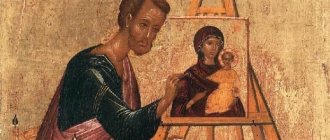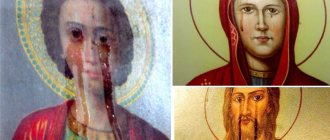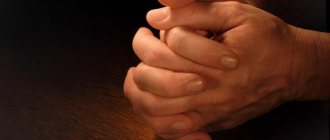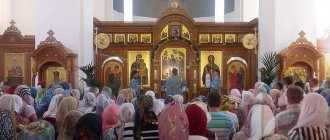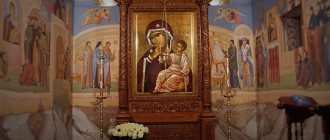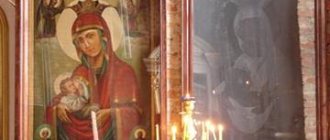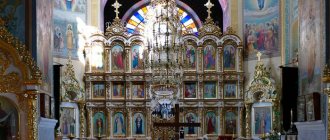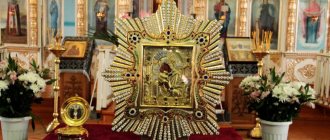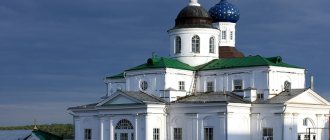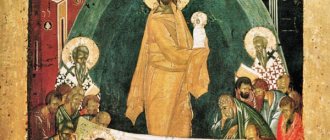How good it is that there are a great many miraculous icons in the world. In our cruel times, when the deficit of love in every individual person is simply off the charts, it is nice to touch and turn to something eternal and giving peace.
Icon of the Mother of God Blessed Womb
Stability and faith in miracles are very important for a person exhausted by stress. When there is an incomprehensible economic situation in the country, and it is unknown what will happen tomorrow, in a situation of complete confusion, the Christian image of the Mother of God is a refuge for the tormented souls of Orthodox people.
The Church has long exalted the image of the Mother of God above all other Saints (Cherubim, Seraphim - the highest angelic ranks). In Christian literature, very little is said about the Mother of God, so many do not understand why we often turn to the Virgin Mary for salvation, and not to Christ himself. The Most Pure One is mentioned in the records only a few times: about her presence next to her son during his life and about her experiences when he suffered martyrdom.
Free Online Tarot Course Eliminate 10 Key Beginner Mistakes and Start Reading Tarot Cards with Ease Without Any Prior Knowledge
GET ACCESS
Tarot and Money 5 steps from love for cards to financial independence from the founder of the Russian Tarot School Sergei Savchenko
FREE SEAT
Runes without fear and energy consumption How to use Runes correctly? Receive 3 gifts that will help you quickly apply Runes to achieve your goals
I WANT A PRESENT
That is why many opponents of the cult of the Mother of God arose. It should be objected, however, that the Creator himself chose Mary as the mother of Christ, and for this reason alone he glorified her. In addition, one should think that Mary possessed outstanding human qualities (tolerance, perseverance and deep faith), since the Creator chose her as the mother of the Savior.
It’s not so easy to obey and send your son to death, knowing in advance that this will happen. The Mother of God endured unimaginable suffering as she watched her son suffer. The woman did this for the sake of saving all people, how can you honor her.
The Mother of God is closest to the Lord. She is very close to him. Therefore, through her it is much easier to be heard by our Savior, since no one like a mother communicates with him easily every day. That is why people often and successfully turn to the Mother of God, build many churches in her honor and paint so many different icons. People feel the great love and help of the Mother of God and are very grateful to her.
What are they praying for?
Watch the video
Who else should a woman turn to during the period of bearing and giving birth to a child, when she is especially vulnerable, if not the Virgin Mary? The Most Pure One herself was a mother and understands very well all the worries of the fairer sex about this: will the baby be healthy, and how will the birth go - these questions, as usual, worry the expectant mother more than anything else.
The icon of the Mother of God “Blessed in the Womb” was created precisely to help pregnant women and women in labor. It is believed that this image was created in Italy on a board made of several varieties of valuable wood. In the 14th century he came to Russian soil. The face was once in Moscow in a luxurious gold frame, which disappeared during the invasion of Napoleonic army. Until 1924, the image was in the Annunciation Cathedral, and then disappeared, and it is still unknown what happened to it.
Temple in the maternity hospital Blessed Womb
Icon of the Mother of God “Helper in Childbirth”, or “Helper for Wives to Give Birth to Children” (“Help in Childbirth”)
(December 26 / January 8)
Before the icon of the Most Holy Theotokos “Help in childbirth” (“Helper for wives to give birth to children”), or “Helper in childbirth” they pray for the safe delivery of pregnant women and to give birth to healthy children.
Prayer to the Most Holy Theotokos before Her icon “Help in Childbirth”
Offering to my queen, my hope to the Mother of God, a refuge for the orphans and the strange, the sorrowful, the joyful, the offended patroness! See my misfortune, see my sorrow, help me as I am weak, guide me as I am strange. Weigh my offense, resolve it, as you will: for I have no other help except You, no other intercessor, no good comforter, except You, O Mother of God, for you will preserve me and cover me forever and ever. Amen.
Troparion, tone 4 To the Mother of God we now diligently attend to sin and humility, and let us fall down in repentance calling from the depths of our souls: Lady, help us, having had mercy on us, struggling, we are perishing from many sins, do not turn away your servants, for you are our only hope imams.
Kontakion, tone 6 The intercession of Christians is not shameful, the intercession to the Creator is immutable, do not despise the voices of sinful prayers, but advance, as the Good One, to the aid of us who faithfully call upon Thee, hasten to prayer and strive to supplicate, ever interceding, the Mother of God, who honor Thee.
Greatness We magnify You, Most Holy Virgin, God-chosen Youth, and honor Your holy image, through which you bring healing to all who come with faith.
Troparion Blessed Womb
Watch the video
As church ministers explain, a troparion is a short song of praise to some Saint or holiday, which expresses the whole essence of the exploits of the martyr or the content of the event. And translated from Greek this concept means “melody”. There are different troparia, right up to the texts of complete services. Kontakia are the same troparia, corresponding songs to the akathists. Kontakia are needed in order to obtain more detailed information about the Saint who is glorified in the song. Troparions are closely related directly to images. In Orthodoxy, every day has its own troparion.
Prayer to the icon
This icon also has another name - the icon of the comforter of aborted babies. To whom does she serve as a comforter? Is it only the murdered babies or their mothers too, who sometimes not of their own free will, but due to life circumstances, were forced to take this terrible step? Let them now atone for their sin before this icon with this prayer:
O Master, Lord Jesus Christ, Son of God! Much of Your goodness, for our sake and for our salvation, man was clothed in flesh, and crucified, and buried, and with Your Blood renewing our corrupted nature, accept my repentance for sins and hear my words: I have sinned, O Lord, in Heaven and before You, in a word , deed, soul and body, and thoughts of my mind. I transgressed Your commandments, did not listen to Your commandment, angered Your goodness, my God, but as Your creation exists, I do not despair of salvation, but boldly come to Your immeasurable Compassion and pray to You: Lord! in repentance, give me a contrite heart and accept me as I pray and give me a good thought, give me tears of tenderness, Lord, let me, by Thy grace, make a good beginning. Have mercy on me, O God, have mercy on me who has fallen, and remember me, Thy sinful servant, in Thy Kingdom, now and ever and unto ages of ages. Amen.
Random test
Quote of the Day
The same actions are virtuous in one case, and sinful in another. What matters is what motivates a person and why.
Priest S. Kruglov
Photo of the day
Audio of the day
This day in history
1882 Born Pavel Aleksandrovich Florensky, Russian religious philosopher and scientist (d. 1937)
How good it is that there are a great many miraculous icons in the world. In our cruel times, when the deficit of love in every individual person is simply off the charts, it is nice to touch and turn to something eternal and giving peace.
Icon of the Mother of God Blessed Womb
Stability and faith in miracles are very important for a person exhausted by stress. When there is an incomprehensible economic situation in the country, and it is unknown what will happen tomorrow, in a situation of complete confusion, the Christian image of the Mother of God is a refuge for the tormented souls of Orthodox people.
The Church has long exalted the image of the Mother of God above all other Saints (Cherubim, Seraphim - the highest angelic ranks). In Christian literature, very little is said about the Mother of God, so many do not understand why we often turn to the Virgin Mary for salvation, and not to Christ himself. The Most Pure One is mentioned in the records only a few times: about her presence next to her son during his life and about her experiences when he suffered martyrdom.
That is why many opponents of the cult of the Mother of God arose. It should be objected, however, that the Creator himself chose Mary as the mother of Christ, and for this reason alone he glorified her. In addition, one should think that Mary possessed outstanding human qualities (tolerance, perseverance and deep faith), since the Creator chose her as the mother of the Savior.
It’s not so easy to obey and send your son to death, knowing in advance that this will happen. The Mother of God endured unimaginable suffering as she watched her son suffer. The woman did this for the sake of saving all people, how can you honor her.
The Mother of God is closest to the Lord. She is very close to him. Therefore, through her it is much easier to be heard by our Savior, since no one like a mother communicates with him easily every day. That is why people often and successfully turn to the Mother of God, build many churches in her honor and paint so many different icons. People feel the great love and help of the Mother of God and are very grateful to her.
Akathist
Each Saint in Orthodoxy has his own akathist. If we literally translate this word, it means “a chant during which it is not customary to sit.” Akathists are also called church hymns. These hymns appeared back in the days of ancient Byzantium; they were also widespread in church literature later. Akathists contain 24 verses, half of which are ikos and half are kontakia.
Ikos and kontakia represent the content of what is said in the akathist: the glorification of the Saint, the story of his life and exploits. In Byzantium, akathists were written only for the Mother of God, and the person who invented them was called an akathistographer. Subsequently, akathists for other Saints appeared. Thus a new genre arose - church hymns to the Saints.
The Greeks still believe that a real akathist exists only for the Virgin Mary, and the rest are just a semblance of an akathist. These are the words of the Akathist, which is read in front of the image of the Mother of God of the Blessed Womb.
Story
The Icon of the Mother of God “Blessed Womb” was in the Annunciation Cathedral of the Moscow Kremlin until 1924; at present its location is unknown.
The Barlovsky copy of this icon was revealed on December 26, 1392, in memory of which a celebration was established on this day. The lines from the Gospel of Luke “Blessed is the womb that bore You, and the breasts that nourished You” (Luke 11:27) served as the name of the icon. The special veneration of the Barlovsky image of the Mother of God is evidenced by the fact that in the cathedral it was placed opposite the royal seat, and in the second half of the 17th century the icon was renewed by the head of the icon painters of the Armory Chamber, Simon Ushakov. The Mother of God on the Moscow icon was depicted in generations, and the Infant Christ reclined, tasting milk from Her breast. According to a handwritten collection of the 18th century, the image was brought to Moscow from the city of Bari, where it was at the tomb of St. Nicholas, Archbishop of Myra, hence the other name of the icon - “Barlovskaya”. On the icon “Blessed Womb” from the collection of the Rybinsk Museum, the Mother of God is represented in the “Mammal” type (in Greek “Galactotrophus”). Tradition says that the image belonged to the Monk Savva the Sanctified († 532) and was in the monastery named after him near Jerusalem. Before his death, the monk predicted that the monastery would be visited by his namesake pilgrim of the royal family, to whom the miraculous image was to be handed over. In the 13th century, Saint Savva of Serbia, in fulfillment of this will, transferred the icon to the Hilandar monastery on Mount Athos, which he founded, where it remains to this day in the Kareya cell and is called the “Typikarnitsa”. In the Rybinsk image, the pose of Christ is dynamic and more complex compared to the ancient monument. An original decorative addition is a frame with a complex wickerwork ornament of the late Baroque type (“Regency style”), apparently borrowed from some Western European engraving.
